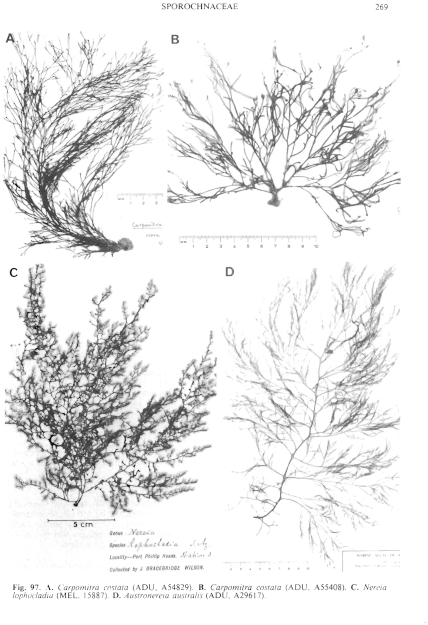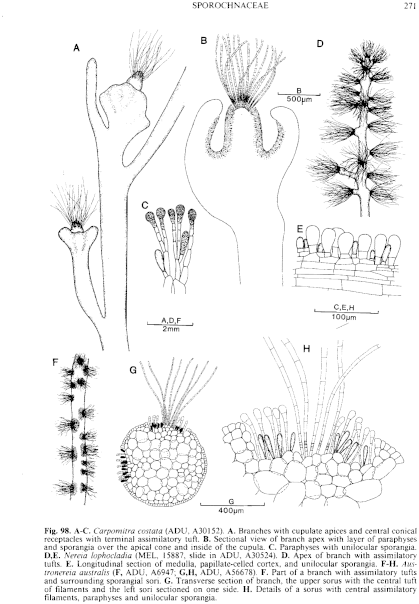|
|
|
|
|
|||||||||||
|
Electronic Flora of South Australia Species Fact Sheet
Phylum Phaeophyta – Order Sporochnales
Selected citations: Lindauer et al. 1961: 245, fig. 61. Womersley 1967: 238.
Synonym
C. cabrerae (Clemente) Kützing 1843: 343. Harvey 1846: pl. 14. Motomura et al. 1985: 21, figs 1–32. Sauvageau 1926: 141, figs 1–17.
Thallus (Fig. 97A,B) medium brown, (5–) 10–25 (–35) cm long, fastigiate, moderately to much branched subdichotomously to laterally, with one to several fronds arising from a rhizoidal holdfast 0.2–1.0 cm across and long; epilithic. Growth apical, from a convex meristem producing compacted filaments below, and with a tuft of assimilatory filaments above, 2–5 (–6) mm long, each with a meristem several cells above their base (Fig. 98B); filaments 22–28 pm in diameter, cells L/B (2–) 3–4 above. Fronds with linear, slightly compressed branches (0.3–) 0.5–1.5 (–2) mm broad, branched at intervals of 0.5–2 (–5) cm, with a faint midrib corresponding to the axial core of elongate cells, and with irregular collars at intervals corresponding to previous fertile apices. Structure haplostichous but pseudoparenchymatous, with a central medullary core of elongate cells, and outer medulla of broader and shorter cells with a 1–3 celled cortex, produced by periclinal divisions near the apical meristems and by further subdivision to form the wings. Surface of cortex smooth, cells 5–8 (–10) µm across and L/B 1–2, densely phaeoplastic.
Reproduction: Reproduction probably periodic. Sporangial paraphyses (Fig. 98C) borne on a conical apex (Fig. 98A,B), surmounted by assimilatory filaments, and on the inside of the subtending, lobed, cupula (Fig. 98B); paraphyses branched, 6–10 cells and 80–160 µm long, expanding upwards with the terminal cell subspherical and 10–20 µm in diameter. Sporangia borne laterally on lower cells of the paraphyses, clavate, 20–40 µm long and 8–14 µm in diameter.
Type from Fowey, Cornwall, England (Rashleigh); in LINN.
Selected specimens: Cape Willoughby, Kangaroo I., S. Aust., drift (Womersley, 16.i.1946; ADU, A3182). Toad Head, West I., S. Aust., 13 m deep (Shepherd, 15.i.1966; ADU, A30152). Nora Creina, S. Aust., shaded pool ( Womersley, 26.ii.1984; ADU, A54829). Portland, Vic., 8–11 m deep N. side Lawrence Rock (Larkum, 2.ix.1971; ADU, A39642). Popes Eye, Port Phillip Heads, Vic., 2–9 m deep (Kain & Engler, 31.viii.1981; ADU, A55408). Gabo I., Vic., 13 m deep (Shepherd, 14.ii.1973; ADU, A43323). Stapleton Point, Prosser Bay, Tas., 8–12 m deep (Olsen, 21.vi.1966; ADU, A30535). Fluted Cape, Bruny I., Tas., 16 m deep (Shepherd, 10.ii.1972; ADU, A41476). Green Cape, N.S.W., 16 m deep (Shepherd, 13.ii.1973; ADU, A43019). Kiama, N.S.W. (May 1939, p. 197).
Distribution: Temperate waters of N. Atlantic, Japan, and the southern hemisphere.
In southern Australia, from West I. and Cape Willoughby, Kangaroo I., S. Aust., to Kiama, N.S.W. and around Tasmania.
Taxonomic notes: Gametophyte (Motomura et al. 1985, p. 21, figs 3–10) filamentous, branched, protandrous, bearing terminal oogonia and lateral, conical, antheridia.
C. costata is a distinctive member of the Sporochnales with its linear, slightly compressed branches and distinctive fertile apices. It is a deep water species (to 38 m) or in shaded pools.
References:
HAMEL, G. (1938). Phéophycées de France. Fasc. IV, pp. 241–336. (Paris.)
HARVEY, W.H. (1846). Phycologia Britannica. Plates 1–72. (Reeve: London.)
KÜTZING, F.T. (1843). Phycologia generalis. (Leipzig.)
LINDAUER, V.W., CHAPMAN, V.J. & AIKEN, M. (1961). The marine algae of New Zealand. II. Phaeophyceae. Nova Hedwigia 3, 129–350, Plates 57–97.
MAY, V. (1939). A key to the marine algae of New South Wales. Part. II. Melanophyceae (Phaeophyceae). Proc. Linn. Soc. N.S.W. 64, 191–215.
MOTOMURA, T., KAWAGUCHI, S. & SAKAI, Y. (1985). Life history and ultrastructure of Carpotnitra cabrerae (Clemente) Kützing (Phaeophyta, Sporochnales). Jap. J. Phycol. 33, 21–31
SAUVAGEAU, C. (1926). Sur l'alternance des générations chez le Carpomitra cabrerae Ktitz. Bull. Stn. biol. Arcachon 23, 141–192.
WOMERSLEY, H.B.S. (1967). A critical survey of the marine algae of southern Australia. II. Phaeophyta. Aust. J. Bot. 15, 189–270.
The Marine Benthic Flora of Southern Australia Part II complete list of references.
Publication:
Womersley, H.B.S. (14 December, 1987)
The Marine Benthic Flora of Southern Australia
Part II
©Board of the Botanic Gardens and State Herbarium, Government of South Australia
Illustrations in Womersley Part II, 1997: FIGS 97A,B, 98 A–C.

Figure 97 enlarge
Fig. 97. A. Carpomitra costata (ADU, A54829). B. Carpomitra costata (ADU, A55408). C. Nereia lophocladia (MEL, 15887). D. Austronereia australis (ADU, A29617).

Figure 98 enlarge
Fig. 98. A–C. Carpomitra costata (ADU, A30152). A. Branches with cupulate apices and central conical receptacles with terminal assimilatory tuft. B. Sectional view of branch apex with layer of paraphyses and sporangia over the apical cone and inside of the cupula. C. Paraphyses with unilocular sporangia. D,E. Nereia lophocladia (MEL, 15887, slide in ADU, A30524). D. Apex of branch with assimilatory tufts. E. Longitudinal section of medulla, papillate-celled cortex, and unilocular sporangia. F–H. Austronereia australis ( F, ADU, A6947; G,H, ADU, A56678). F. Part of a branch with assimilatory tufts and surrounding sporangial sofi. G. Transverse section of branch, the upper sorus with the central tuft of filaments and the left sori sectioned on one side. H. Details of a sorus with central assimilatory filaments, paraphyses and unilocular sporangia.

|
Email Contact: State Herbarium of South Australia |

|